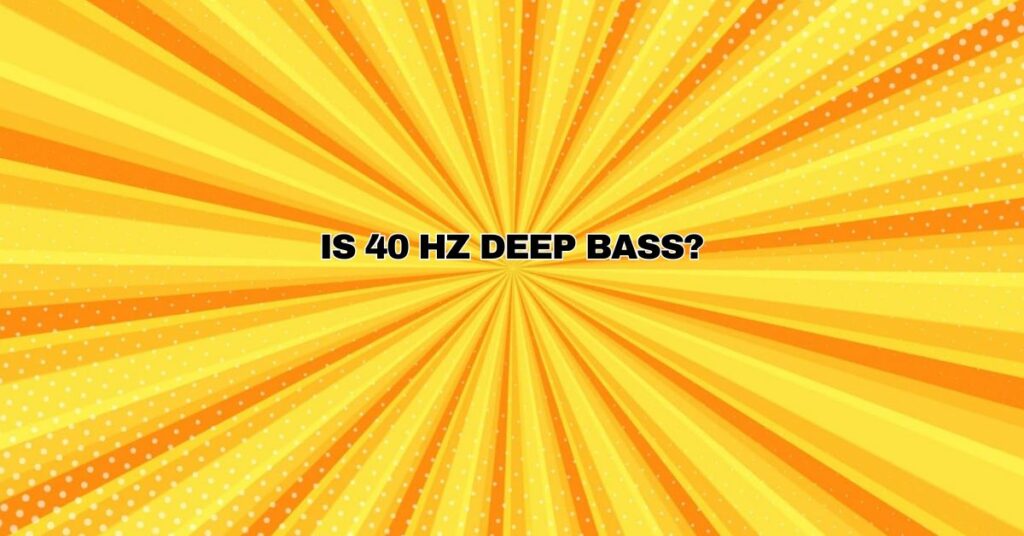Sound, a powerful and immersive force, can evoke emotions, set the tone, and transport us to another world. Within this realm of auditory experiences, bass frequencies hold a special place, influencing how we perceive music, movies, and even live events. One frequent point of discussion in the audio world is whether 40 Hz qualifies as deep bass. In this comprehensive article, we will venture into the captivating world of low-frequency sound, explore the concept of deep bass, and discern the role of 40 Hz in shaping our sonic landscapes.
Read Also : Is 60hz low bass?
Understanding Sound Frequency
Before delving into the question of whether 40 Hz can be classified as deep bass, it’s vital to comprehend the basics of sound frequencies. Frequency, typically measured in Hertz (Hz), denotes the number of oscillations or cycles of a sound wave that occur in one second. The human auditory range typically spans from about 20 Hz to 20,000 Hz (20 kHz), with variation occurring based on age, hearing health, and other factors.
Low-frequency sound, often associated with bass, falls at the lower end of the frequency spectrum. These frequencies create the resonant and tactile sensations that we associate with deep bass, often felt as much as they are heard. The range of low bass frequencies typically encompasses those below 250 Hz.
Defining Deep Bass
Deep bass, as the term suggests, refers to the lowest frequencies in the audio spectrum. These frequencies are responsible for the earth-shaking, chest-thumping sensations that can enhance our audio experiences. Deep bass frequencies extend from approximately 20 Hz to 80 Hz, with the sub-bass portion (below 60 Hz) being particularly notable for its ability to create powerful, immersive effects.
Is 40 Hz Considered Deep Bass?
In the realm of deep bass, 40 Hz undoubtedly qualifies as a part of this low-frequency spectrum. It falls within the sub-bass category, which is known for producing vibrations and tactile sensations that can be felt throughout the body. While some may consider deep bass to start below 30 Hz, others recognize 40 Hz as the lower boundary of deep bass.
The sub-bass frequencies, including 40 Hz, play a vital role in various musical genres and audio contexts:
- Electronic Dance Music (EDM): Genres like dubstep and drum and bass often utilize sub-bass frequencies, including 40 Hz, to create the signature pulsating and powerful basslines that drive these genres.
- Hip-Hop and Rap: In hip-hop and rap music, sub-bass frequencies around 40 Hz add weight and impact to the basslines, making them sound robust and resonant.
- Movie Soundtracks: Deep bass frequencies, including 40 Hz, are essential for cinematic experiences. Explosions, dramatic moments, and atmospheric soundscapes often rely on these frequencies to create the desired impact.
The Perception of Deep Bass
The perception of deep bass, including the significance of 40 Hz, is influenced by various factors, including listening environments and individual preferences. Room acoustics, for instance, can either enhance or attenuate specific frequencies, affecting how deep bass is experienced.
Proper room treatment, such as bass traps and acoustic panels, can address acoustic issues and ensure that deep bass frequencies are reproduced accurately. Moreover, advanced audio systems with room calibration capabilities can further optimize the listening experience.
Conclusion
In the world of sound, the question of whether 40 Hz is considered deep bass has a clear answer: yes, it is indeed a part of the sub-bass category. Deep bass frequencies, including 40 Hz, are integral to audio experiences, creating powerful, tactile, and immersive sensations. Whether you’re a music enthusiast, a film buff, or an audiophile, understanding the role of 40 Hz in shaping soundscapes is crucial to appreciating and enhancing the power and emotion of audio. Ultimately, the perception of deep bass is subjective, influenced by individual preferences and the context in which it is experienced, making it a dynamic and integral component of the auditory world.


